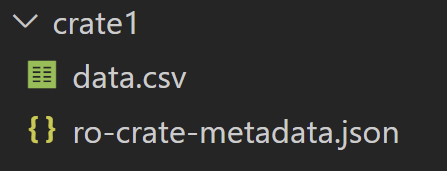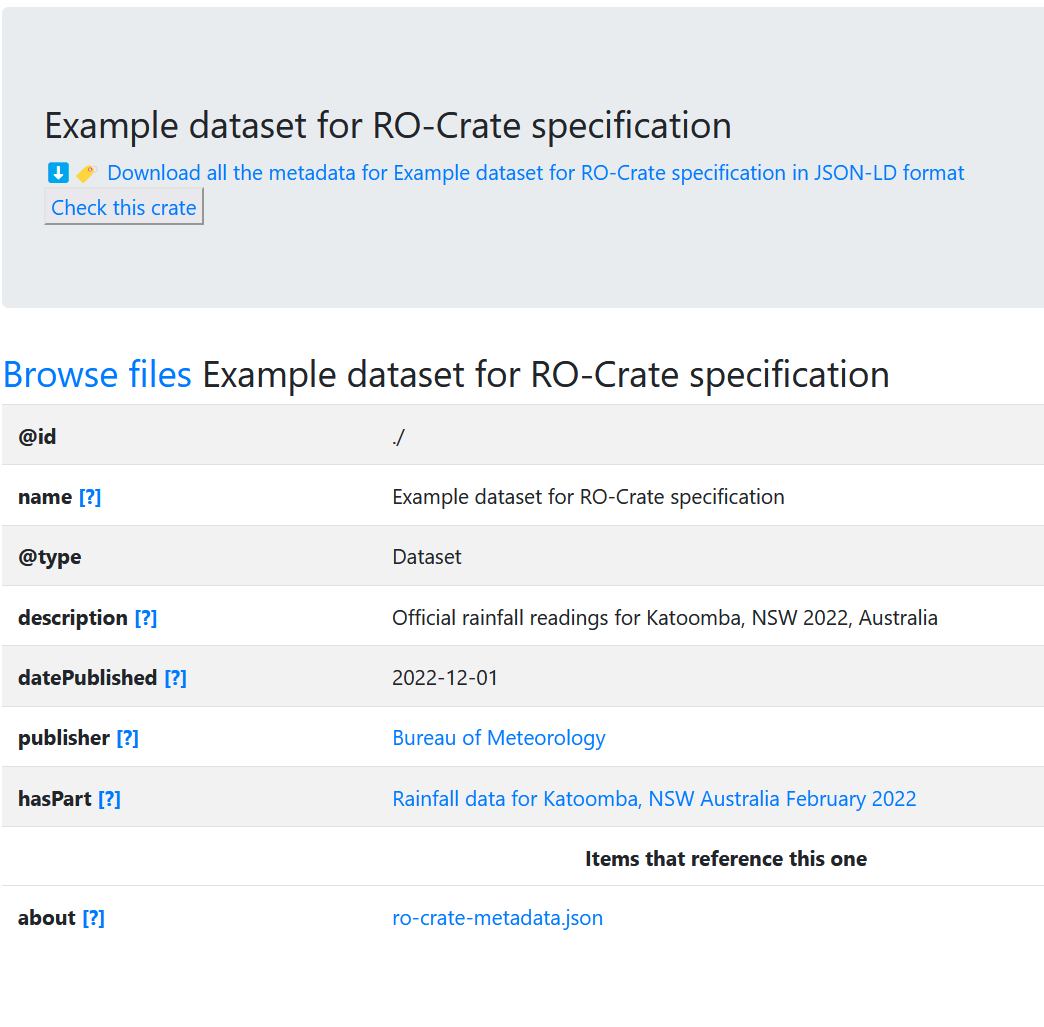Introduction
This document specifies a method, known as RO-Crate (Research Object Crate), of aggregating and describing data for distribution, re-use, publishing, preservation and archiving. RO-Crates aggregate data into a Dataset, and may describe any resource including files, URI-addressable resources, or use other addressing schemes to locate digital or physical data. Describing resources includes technical metadata such as file sizes and types as well as contextual information including how datasets and files were created, and where, how they were collated and collected, who was involved in the process, what equipment and software was used, who funded the work, how to cite it, and crucially, how it may be reused, and by whom.
The core of RO-Crate is a machine-readable linked-data document in JSON-LD format known as an RO-Crate Metadata Document. RO-Crate metadata documents can to a large extent be created and processed just like any other JSON: knowledge of JSON-LD is not needed, unless extending RO-Crate with additional concepts or combining RO-Crate with other Linked Data technologies.
This page introduces the general RO-Crate concepts through a running example, while the normative pages in the rest of the RO-Crate specification define in more detail these and other concepts using separate examples and recommendations.
Walkthrough: An initial RO-Crate
In the simplest form, to describe some data on disk, an RO-Crate Metadata Document named ro-crate-metadata.json is placed in a directory alongside a set of files or directories.
In the example below, a single file data.csv is placed with the RO-Crate Metadata Document in a directory named crate1:

ro-crate-metadata.jsonThe presence of the ro-crate-metadata.json file means that crate1 and its children can now be considered to be an RO-Crate.
Running example
In this running example, the content of the RO Crate Metadata document is:
{
"@context": "https://w3id.org/ro/crate/1.2-DRAFT/context",
"@graph": [
{
"@id": "ro-crate-metadata.json",
"@type": "CreativeWork",
"conformsTo": {"@id": "https://w3id.org/ro/crate/1.2-DRAFT"},
"about": {"@id": "./"}
},
{
"@id": "./",
"@type": "Dataset",
"name": "Example dataset for RO-Crate specification",
"description": "Official rainfall readings for Katoomba, NSW 2022, Australia",
"datePublished": "2022-12-01",
"publisher": {"@id": "https://ror.org/04dkp1p98"},
"license": {"@id": "http://spdx.org/licenses/CC0-1.0"},
"hasPart": [
{"@id": "data.csv"}
]
},
{
"@id": "data.csv",
"@type": "File",
"name": "Rainfall data for Katoomba, NSW Australia February 2022",
"encodingFormat": "text/csv",
"license": {"@id": "https://creativecommons.org/licenses/by-nc-sa/3.0/au/"}
},
{
"@id": "https://ror.org/04dkp1p98",
"@type": "Organization",
"name": "Bureau of Meteorology",
"description": "Australian Government Bureau of Meteorology",
"url": "http://www.bom.gov.au/"
},
{
"@id": "https://creativecommons.org/licenses/by-nc-sa/3.0/au/",
"@type": "CreativeWork",
"name": "CC BY-NC-SA 3.0 AU",
"description": "Creative Commons Attribution-NonCommercial-ShareAlike 3.0 Australia"
}
]
}
JSON-LD preamble
The preamble of @context and @graph are JSON-LD structures that help provide global identifiers to the JSON keys and types used in the rest of the RO-Crate document. These will largely map to definitions in the schema.org vocabulary, which can be used by RO-Crate extensions to provide additional metadata beyond the RO-Crate specifications. It is this feature of JSON-LD that helps make RO-Crate extensible for many different purposes – this is explored further in appendix on JSON-LD.
However, in the general case it should be sufficient to follow the RO-Crate JSON examples directly without deeper JSON-LD understanding. In short, an RO-Crate metadata file contains a flat list of entities as objects in the @graph array. These entities are cross-referenced using @id identifiers rather than being deeply nested.
RO-Crate Metadata descriptor
The first JSON-LD entity in our example above has the @id ro-crate-metadata.json:
{
"@id": "ro-crate-metadata.json",
"@type": "CreativeWork",
"conformsTo": {"@id": "https://w3id.org/ro/crate/1.2-DRAFT"},
"about": {"@id": "./"}
}
This required entity, known as the RO-Crate Metadata Descriptor, helps this file self-identify as an RO-Crate Metadata Document, which is conforming to (conformsTo) the RO-Crate specification version 1.2-DRAFT.
The descriptor also indicates via the about property which entity in the @graph array is the RO-Crate Root Dataset – the starting point of this RO-Crate.
RO-Crate Root
We can visualise how the above entity references the RO-Crate Root as:
about property pointing at the RO-Crate Root entity with matching @idBy convention, in RO-Crate the @id value of ./ means that this document describes the directory of content in which the RO-Crate metadata is located as in the example above. This reference from ro-crate-metadata.json is therefore marking the crate1 directory as being the RO-Crate root.
This example is a directory-based RO-Crate stored on disk. If the crate is being served from a Web service, such as a data repository or database where files are not organized in directories, then the @id might be an absolute URI instead of "./" – see section Root Data Entity for details
About cross-references
In RO-Crate Metadata Files, entities are cross-referenced using @id reference objects, rather than using deeply nested JSON objects. In short, this flattened JSON-LD style allows any entity to reference any other entity, and RO-Crate consumers to directly find all the descriptions of an entity within a single JSON object. So let’s have a look at the Root Data Entity ./:
{
"@id": "./",
"@type": "Dataset",
"…": "…",
"hasPart": [ {"@id": "data.csv"} ]
}
The root is always typed Dataset and has several metadata properties that describe the RO-Crate as a whole, as a collection of resources. The section on root data entity explores further the required and recommended properties of the root ./.
Data entities
A main type of resources collected are data – simplifying, we can consider data as any kind of file that can be opened in other programs. These are aggregated by the Root Dataset with the hasPart property. In this example we have an array with a single value, a reference to the entity describing the file data.csv.
RO-Crates can also contain data entities that are folders and Web resources, as well as non-File-like data like online databases – see section on data entities.
@id identifier data.csvIf we now follow the @id reference for the corresponding data entity JSON block, we see it has @type value of File and additional metadata such as encodingFormat. It is recommended that every entity has a human readable name, which as shown in this example, does not need to match the filename/identifier. The encodingFormat indicates the media file type so that consumers of the crate can open data.csv in an appropriate program.
{
"@id": "data.csv",
"@type": "File",
"name": "Rainfall data for Katoomba, NSW Australia February 2022",
"encodingFormat": "text/csv",
"license": { "@id": "https://creativecommons.org/licenses/by-nc-sa/3.0/au/" }
},
For more information on describing files and directories, including their recommended and required attributes, see section on data entities.
Contextual entities
Moving back to the RO-Crate root ./, the publisher of this Dataset should be indicated using the property publisher using a URI to identify the Organization, linking to what is known as a Contextual Entity that provides some information about the Organization such as its name and web address.
{
"@id": "./",
"@type": "Dataset",
"publisher": {"@id": "https://ror.org/04dkp1p98"},
"…": "…"
}
{
"@id": "https://ror.org/04dkp1p98",
"@type": "Organization",
"name": "Bureau of Meteorology",
"description": "Australian Government Bureau of Meteorology",
"url": "http://www.bom.gov.au/"
}
You may notice the subtle difference between a data entity that is conceptually part of the RO-Crate and is file-like (containing bytes), while this contextual entity is a representation of a real-life organization that can’t be downloaded: following the URL, we would only get its description. The section contextual entities explores several of the entities that can be added to the RO-Crate to provide it with a context, for instance authors and their affiliations. Simplifying slightly, a data entity is referenced from hasPart in a Dataset, while a contextual entity is referenced using any other defined property.
HTML preview
An RO-Crate can be distributed on disk, in packaged format such as a zip file or disk image, or placed on a static website. In any of these cases, an RO-Crate should have an accompanying HTML version (ro-crate-metadata.html) designed to be human-readable. The exact contents of the preview may vary but should correspond to the RO-Crate Metadata file content and link to the contained data entities. The preview may be generated automatically from the RO-Crate Metadata Document (see RO-Crate tools), or even by hand (equivalent to a README).
Below is a preview of the running example:

Overview of specification
The rest of this specification is structured as follows:
- Terminology defines terms such as Entity used in the rest of the document. You may use this page as a quick-reference, but note that most of these are also covered in detail in separate pages.
- RO-Crate structure defines further how the
ro-crate-metadata.jsonand data files can be organized within an RO-Crate Root directory - Metadata of the RO-Crate explains the connection to Linked Data principles and how RO-Crate keys are mapped to global identifiers. This is mainly of interest for readers already familiar with JSON-LD or ontologies, or which want to expand RO-Crate metadata keys.
- Root Data Entity defines the entities RO-Crate Metadata Descriptor (
ro-crate-metdata.json) and RO-Crate Root (./) including their required and recommended properties. - Data Entities explores further how to describe data, including files, directories and Web references. Metadata such as file formats help inform RO-Crate consumers on which tools may be able to process the data.
- Contextual Entities shows how to describe entities used to annotate other entities, adding
PeopleandOrganizationreferenced fromauthor,publication,affiliationetc. Metadata like licensing, funding, locations and subjects can be described using contextual entities. - Provenance of Entities explores how the history of making an entity can be added to the RO-Crate using a series of actions – this may include real-world activities and instruments, as well as software executions and modifications to the RO-Crate metadata itself.
- Subsection Digital Library and Repository content details how records in an existing repository (which may reference files, but also physical objects) can be described and published using RO-Crate.
- Workflows and Scripts explains how computional software and code can be added to an RO-Crate, possibly as part of explaining provenance, but also for providing potential usage and further processing of the data.
- Profiles formalises how a set of RO-Crates can indicate they are conforming to a specific profile, which may add additional requirements beyond this general RO-Crate specification. Profiles may add additional terms from
schema.organd other vocabularies, or require a certain type of data entity used in a particular research domain. Profiles can themselves be expressed as an RO-Crate, explored in this section. - Appendixes contain more technical references and suggestions for developers, e.g. for deciding on
@idin JSON-LD or extending RO-Crate terms. The appendix also explores how an RO-Crate can be packaged with BagIt or used as part of a repository.
Throughout the specifications you will find references to the keys and types reused from schema.org through the JSON-LD context, for instance Dataset, which define many more properties than the ones highlighted by pages like Root Data Entity. The intention is that the RO-Crate specification gives a common minimum of metadata, and that producers of RO-Crate can use additional schema.org types and properties as needed. When some patterns emerge from such extensions they can be formalized in a published profile to ensure they are also used consistently.